ignition Alfa Romeo 8C 2010 Owner handbook (in English)
[x] Cancel search | Manufacturer: ALFA ROMEO, Model Year: 2010, Model line: 8C, Model: Alfa Romeo 8C 2010Pages: 223, PDF Size: 14.35 MB
Page 61 of 223
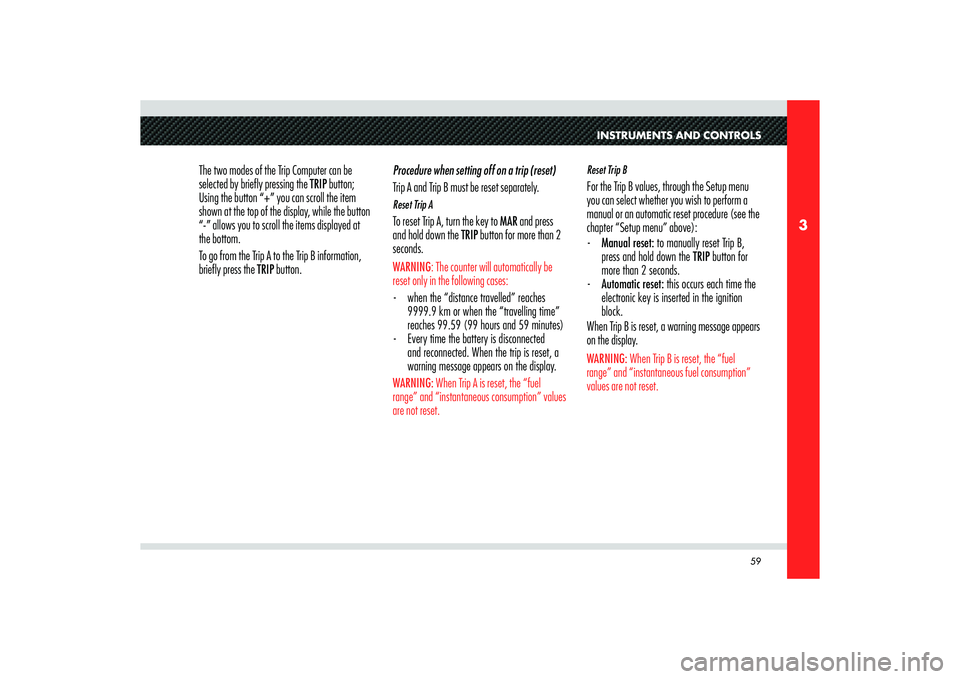
59
3
INSTRUMENTS AND CONTROLS
The two modes of the Trip Computer can be
selected by briefly pressing the TRIP button;
Using the button “+” you can scroll the item
shown at the top of the display, while the button
“-” allows you to scroll the items displayed at
the bottom.
To go from the Trip A to the Trip B information,
briefly press the TRIP button.Procedure when setting off on a trip (reset)
Trip A and Trip B must be reset separately.
Reset Trip ATo reset Trip A, turn the key to MAR and press
and hold down the TRIP button for more than 2
seconds. WARNING: The counter will automatically be
reset only in the following cases:- when the “distance travelled” reaches
9999.9 km or when the “travelling time”
reaches 99.59 (99 hours and 59 minutes)
- Every time the battery is disconnected
and reconnected. When the trip is reset, a
warning message appears on the display.WARNING: When Trip A is reset, the “fuel
range” and “instantaneous consumption” values
are not reset.
Reset Trip BFor the Trip B values, through the Setup menu
you can select whether you wish to perform a
manual or an automatic reset procedure (see the
chapter “Setup menu” above):
- Manual reset: to manually reset Trip B,
press and hold down the TRIP button for
more than 2 seconds.
- Automatic reset: this occurs each time the
electronic key is inserted in the ignition
block.
When Trip B is reset, a warning message appears
on the display.WARNING: When Trip B is reset, the “fuel
range” and “instantaneous fuel consumption”
values are not reset.
Page 63 of 223
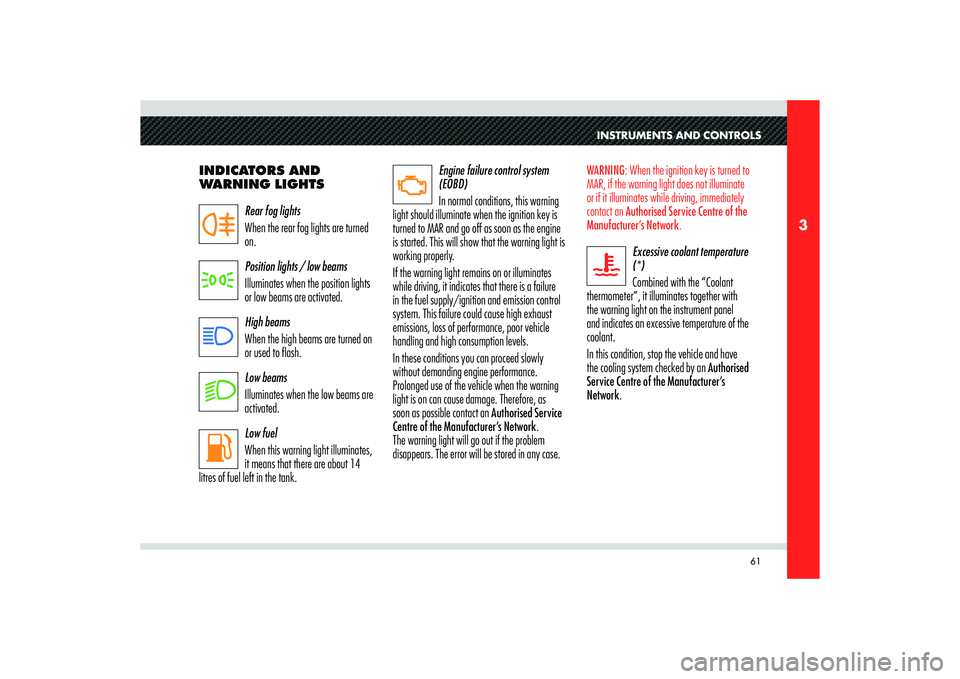
61
3
INSTRUMENTS AND CONTROLSWARNING: When the ignition key is turned to
MAR, if the warning light does not illuminate
or if it illuminates while driving, immediately
contact an Authorised Service Centre of the
Manufacturer’s Network.
Excessive coolant temperature
(*)
Combined with the “Coolant
thermometer”, it illuminates together with
the warning light on the instrument panel
and indicates an excessive temperature of the
coolant.
In this condition, stop the vehicle and have
the cooling system checked by an Authorised
Service Centre of the Manufacturer’s
Network. INDICATORS AND
WARNING LIGHTS
Rear fog lights
When the rear fog lights are turned
on.
Position lights / low beams
Illuminates when the position lights
or low beams are activated.
High beams
When the high beams are turned on
or used to flash.
Low beams
Illuminates when the low beams are
activated.
Low fuel
When this warning light illuminates,
it means that there are about 14
litres of fuel left in the tank.Engine failure control system
(EOBD)
In normal conditions, this warning
light should illuminate when the ignition key is
turned to MAR and go off as soon as the engine
is started. This will show that the warning light is
working properly.
If the warning light remains on or illuminates
while driving, it indicates that there is a failure
in the fuel supply/ignition and emission control
system. This failure could cause high exhaust
emissions, loss of performance, poor vehicle
handling and high consumption levels.
In these conditions you can proceed slowly
without demanding engine performance.
Prolonged use of the vehicle when the warning
light is on can cause damage. Therefore, as
soon as possible contact an Authorised Service
Centre of the Manufacturer’s Network.
The warning light will go out if the problem
disappears. The error will be stored in any case.
Page 64 of 223
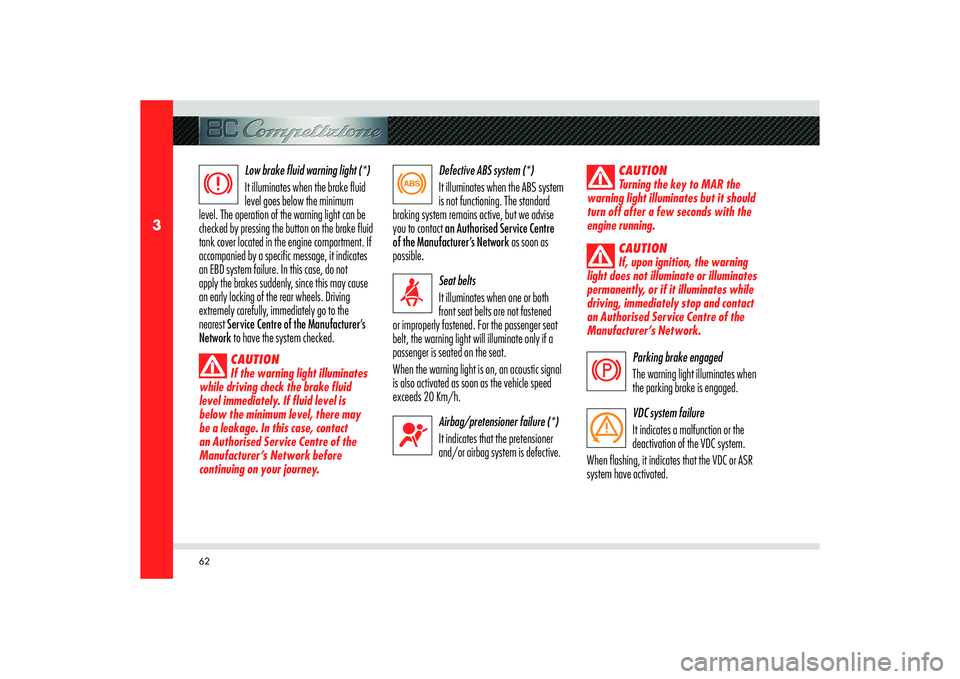
62
3
Low brake fluid warning light (*)
It illuminates when the brake fluid
level goes below the minimum
level. The operation of the warning light can be
checked by pressing the button on the brake fluid
tank cover located in the engine compartment. If
accompanied by a specific message, it indicates
an EBD system failure. In this case, do not
apply the brakes suddenly, since this may cause
an early locking of the rear wheels. Driving
extremely carefully, immediately go to the
nearest Service Centre of the Manufacturer’s
Network to have the system checked.
CAUTION
If the warning light illuminates
while driving check the brake fluid
level immediately. If fluid level is
below the minimum level, there may
be a leakage. In this case, contact
an Authorised Service Centre of the
Manufacturer’s Network before
continuing on your journey.
Defective ABS system (*)
It illuminates when the ABS system
is not functioning. The standard
braking system remains active, but we advise
you to contact an Authorised Service Centre
of the Manufacturer’s Network as soon as
possible.
Seat belts
It illuminates when one or both
front seat belts are not fastened
or improperly fastened. For the passenger seat
belt, the warning light will illuminate only if a
passenger is seated on the seat.
When the warning light is on, an acoustic signal
is also activated as soon as the vehicle speed
exceeds 20 Km/h.
Airbag/pretensioner failure (*)
It indicates that the pretensioner
and/or airbag system is defective.
CAUTION
Turning the key to MAR the
warning light illuminates but it should
turn off after a few seconds with the
engine running.
CAUTION
If, upon ignition, the warning
light does not illuminate or illuminates
permanently, or if it illuminates while
driving, immediately stop and contact
an Authorised Service Centre of the
Manufacturer’s Network.
Parking brake engaged
The warning light illuminates when
the parking brake is engaged.
VDC system failure
It indicates a malfunction or the
deactivation of the VDC system.
When flashing, it indicates that the VDC or ASR
system have activated.
Page 72 of 223
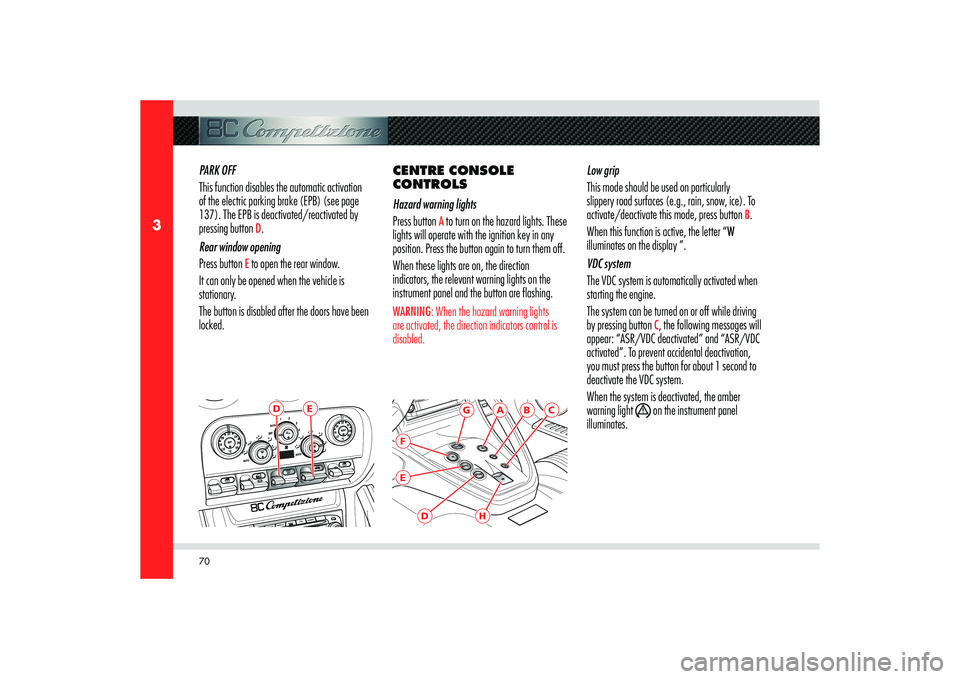
70
3
E
D
B
A
G
FE
D
H
C
PARK OFF
This function disables the automatic activation
of the electric parking brake (EPB) (see page
137). The EPB is deactivated/reactivated by
pressing button
D.
Rear window opening
Press button
E to open the rear window.
It can only be opened when the vehicle is
stationary.
The button is disabled after the doors have been
locked.CENTRE CONSOLE
CONTROLS
Hazard warning lights
Press button
A to turn on the hazard lights. These
lights will operate with the ignition key in any
position. Press the button again to turn them off.
When these lights are on, the direction
indicators, the relevant warning lights on the
instrument panel and the button are flashing.
WARNING: When the hazard warning lights
are activated, the direction indicators control is
disabled.
Low grip
This mode should be used on particularly
slippery road surfaces (e.g., rain, snow, ice). To
activate/deactivate this mode, press button
B.
When this function is active, the letter “W
illuminates on the display ”.
VDC system
The VDC system is automatically activated when
starting the engine.
The system can be turned on or off while driving
by pressing button
C, the following messages will
appear: “ASR/VDC deactivated” and “ASR/VDC
activated”. To prevent accidental deactivation,
you must press the button for about 1 second to
deactivate the VDC system.
When the system is deactivated, the amber
warning light
on the instrument panel
illuminates.
Page 79 of 223
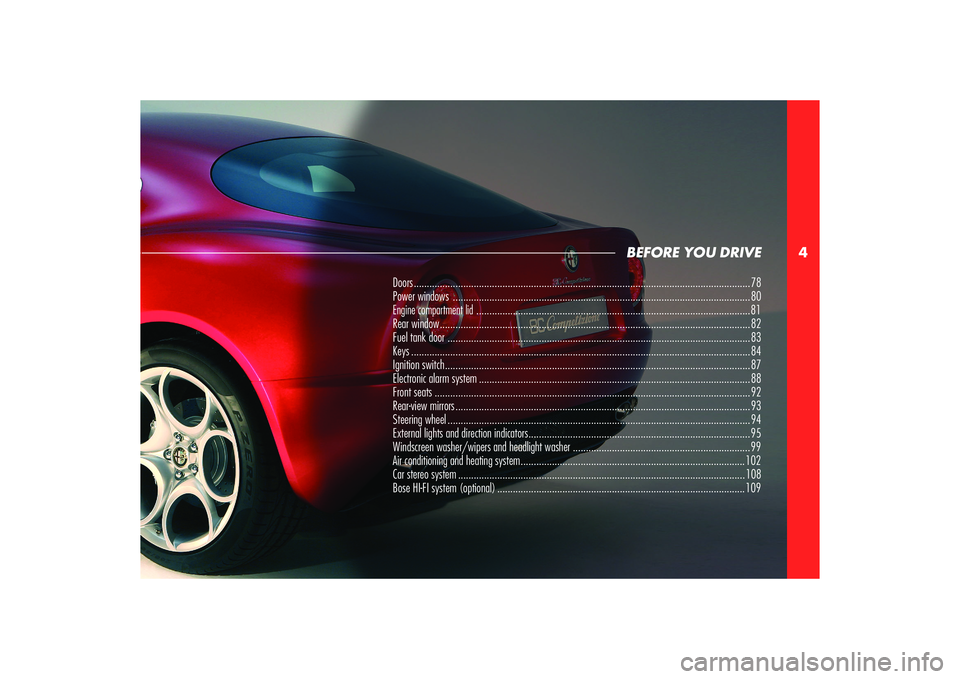
4
BEFORE YOU DRIVE
Doors ................................................................................................................................. 78
Power windows .................................................................................................................. 80Engine compartment lid
......................................................................................................... 81
Rear window ....................................................................................................................... 82
Fuel tank door .................................................................................................................... 83
Keys .................................................................................................................................. 84
Ignition switch ..................................................................................................................... 87
Electronic alarm system ........................................................................................................88
Front seats ......................................................................................................................... 92
Rear-view mirrors ................................................................................................................. 93
Steering wheel .................................................................................................................... 94
External lights and direction indicators ..................................................................................... 95
Windscreen washer/wipers and headlight washer .................................................................... 99
Air conditioning and heating system ...................................................................................... 102
Car stereo system .............................................................................................................. 108
Bose HI-FI system (optional) ............................................................................................... 109
Page 82 of 223

80
4
A
B
POWER
WINDOWS Activation is only possible with the ignition key in
the MAR position.
The power window controls are positioned on the
centre console.A - Front left-hand window opening/closingB - Front right-hand window opening/closing.
Lower the power window with the key turned
to MAR to activate automatic operation: the
window will stop when it reaches the end of its
travel (or when the button is pressed again).
A brief pressure causes a small movement of the window, which stops when the button is
released.
When the window is raised, automatic operation
is active only for the left-hand window.
WARNING: If the window is operated with the
door open, when it reaches the upper limit it
will go down for a short distance so as not to
interfere with the weather strip when the door
is closed.
CAUTION
When the door is opened, the
window is slightly lowered and then
closes automatically after the door is
closed: take the greatest care to avoid
passengers (especially children) being
near the windows when opening/
closing the doors.CAUTION
Improper use of the power
windows can be dangerous. Check
that passengers are away from the
side windows before shutting them.
Always remove the ignition key when
you get out of the vehicle, in order to
avoid that accidental activation of the
power windows may be dangerous for
passengers remaining in the vehicle.
CAUTION
Leaving children in a parked
vehicle with the windows closed is
dangerous: the temperature inside
the vehicle can reach very high levels,
causing fainting and serious injuries.
Page 84 of 223
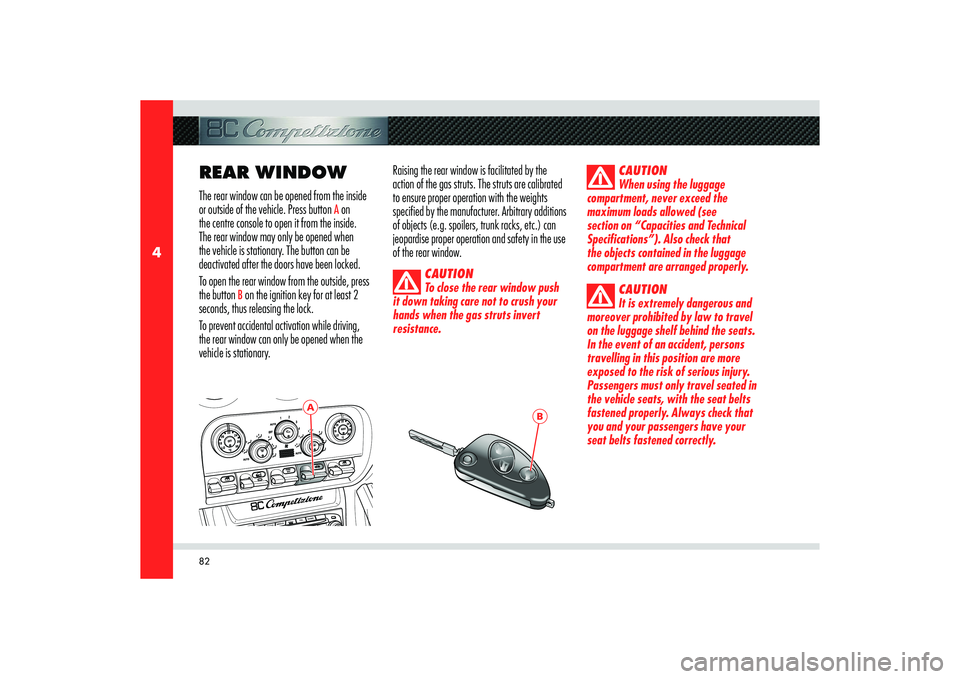
82
4
A
B
REAR WINDOWThe rear window can be opened from the inside
or outside of the vehicle. Press button
A on
the centre console to open it from the inside.
The rear window may only be opened when
the vehicle is stationary. The button can be
deactivated after the doors have been locked.
To open the rear window from the outside, press
the button
B on the ignition key for at least 2
seconds, thus releasing the lock.
To prevent accidental activation while driving,
the rear window can only be opened when the
vehicle is stationary.Raising the rear window is facilitated by the
action of the gas struts. The struts are calibrated
to ensure proper operation with the weights
specified by the manufacturer. Arbitrary additions
of objects (e.g. spoilers, trunk racks, etc.) can
jeopardise proper operation and safety in the use
of the rear window.
CAUTION
To close the rear window push
it down taking care not to crush your
hands when the gas struts invert
resistance.
CAUTION
When using the luggage
compartment, never exceed the
maximum loads allowed (see
section on “Capacities and Technical
Specifications”). Also check that
the objects contained in the luggage
compartment are arranged properly.
CAUTION
It is extremely dangerous and
moreover prohibited by law to travel
on the luggage shelf behind the seats.
In the event of an accident, persons
travelling in this position are more
exposed to the risk of serious injury.
Passengers must only travel seated in
the vehicle seats, with the seat belts
fastened properly. Always check that
you and your passengers have your
seat belts fastened correctly.
Page 86 of 223
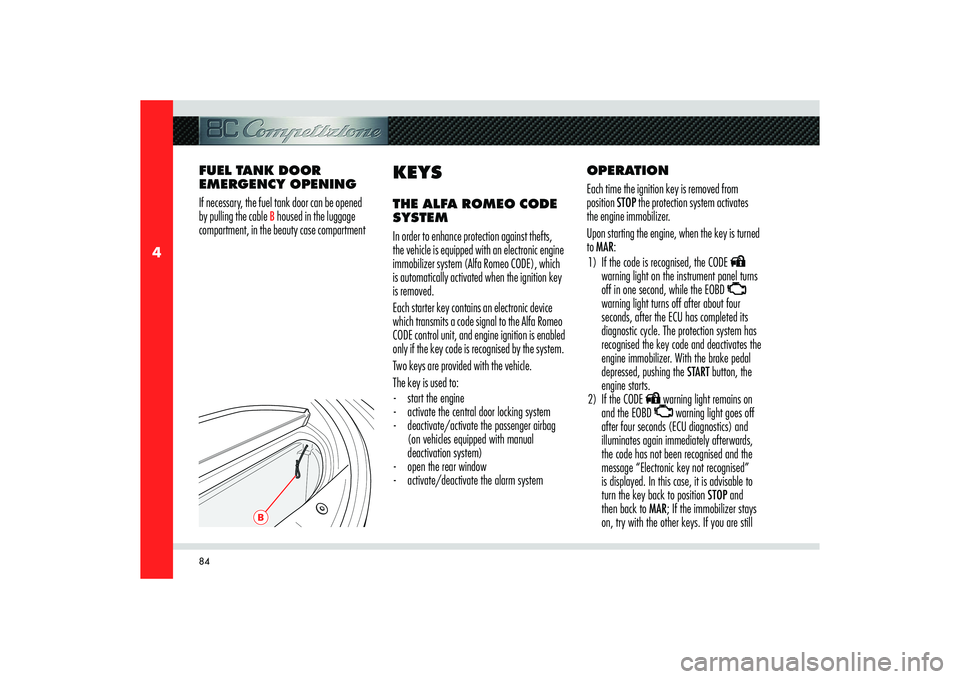
84
4
B
OPERATION
Each time the ignition key is removed from
position STOP the protection system activates
the engine immobilizer.
Upon starting the engine, when the key is turned
to MAR:
1) If the code is recognised, the CODE
warning light on the instrument panel turns
off in one second, while the EOBD
warning light turns off after about four
seconds, after the ECU has completed its
diagnostic cycle. The protection system has
recognised the key code and deactivates the
engine immobilizer. With the brake pedal
depressed, pushing the START button, the
engine starts.
2) If the CODE warning light remains on
and the EOBD warning light goes off
after four seconds (ECU diagnostics) and
illuminates again immediately afterwards,
the code has not been recognised and the
message “Electronic key not recognised”
is displayed. In this case, it is advisable to
turn the key back to position STOP and
then back to MAR; If the immobilizer stays
on, try with the other keys. If you are still FUEL TANK DOOR
EMERGENCY OPENING
If necessary, the fuel tank door can be opened
by pulling the cable
B housed in the luggage
compartment, in the beauty case compartment
KEYSTHE ALFA ROMEO CODE
SYSTEM
In order to enhance protection against thefts,
the vehicle is equipped with an electronic engine
immobilizer system (Alfa Romeo CODE), which
is automatically activated when the ignition key
is removed.
Each starter key contains an electronic device
which transmits a code signal to the Alfa Romeo
CODE control unit, and engine ignition is enabled
only if the key code is recognised by the system.
Two keys are provided with the vehicle.
The key is used to:
- start the engine
- activate the central door locking system
- deactivate/activate the passenger airbag
(on vehicles equipped with manual
deactivation system)
- open the rear window
- activate/deactivate the alarm system
Page 87 of 223
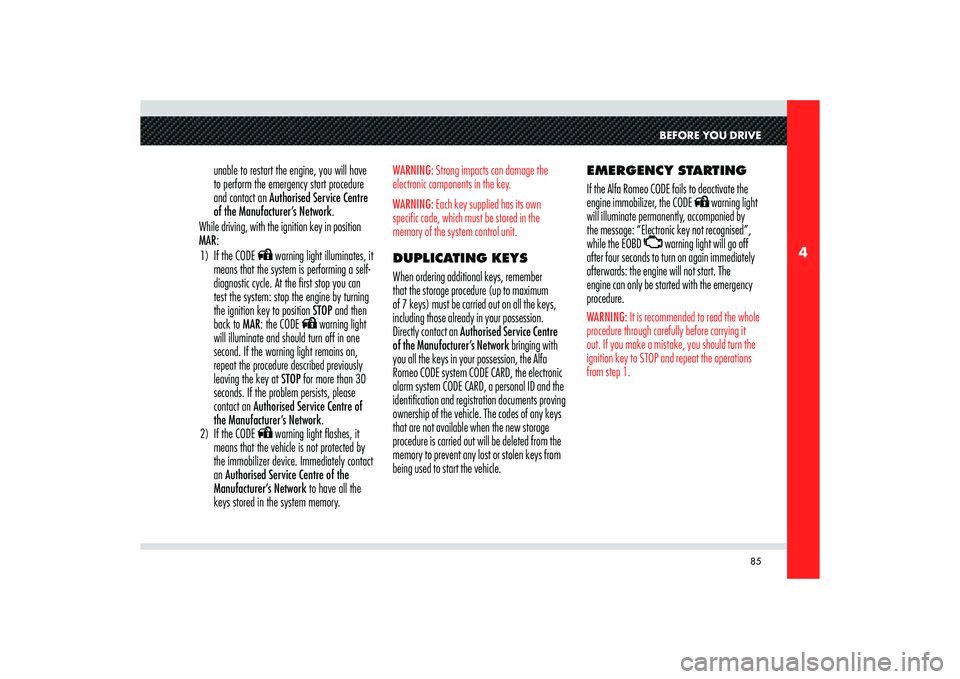
85
4
BEFORE YOU DRIVE
unable to restart the engine, you will have
to perform the emergency start procedure
and contact an Authorised Service Centre
of the Manufacturer’s Network.
While driving, with the ignition key in position
MAR:
1) If the CODE
warning light illuminates, it
means that the system is performing a self-
diagnostic cycle. At the fi rst stop you can
test the system: stop the engine by turning
the ignition key to position STOP and then
back to MAR: the CODE warning light
will illuminate and should turn off in one
second. If the warning light remains on,
repeat the procedure described previously
leaving the key at STOP for more than 30
seconds. If the problem persists, please
contact an Authorised Service Centre of
the Manufacturer’s Network.
2) If the CODE warning light fl ashes, it
means that the vehicle is not protected by
the immobilizer device. Immediately contact
an Authorised Service Centre of the
Manufacturer’s Network to have all the
keys stored in the system memory.
WARNING: Strong impacts can damage the
electronic components in the key.
WARNING: Each key supplied has its own
specific code, which must be stored in the
memory of the system control unit.DUPLICATING KEYS
When ordering additional keys, remember
that the storage procedure (up to maximum
of 7 keys) must be carried out on all the keys,
including those already in your possession.
Directly contact an Authorised Service Centre
of the Manufacturer’s Network bringing with
you all the keys in your possession, the Alfa
Romeo CODE system CODE CARD, the electronic
alarm system CODE CARD, a personal ID and the
identification and registration documents proving
ownership of the vehicle. The codes of any keys
that are not available when the new storage
procedure is carried out will be deleted from the
memory to prevent any lost or stolen keys from
being used to start the vehicle.EMERGENCY STARTING
If the Alfa Romeo CODE fails to deactivate the
engine immobilizer, the CODE
warning light
will illuminate permanently, accompanied by
the message: “Electronic key not recognised”,
while the EOBD warning light will go off
after four seconds to turn on again immediately
afterwards: the engine will not start. The
engine can only be started with the emergency
procedure.
WARNING: It is recommended to read the whole
procedure through carefully before carrying it
out. If you make a mistake, you should turn the
ignition key to STOP and repeat the operations
from step 1.
Page 88 of 223
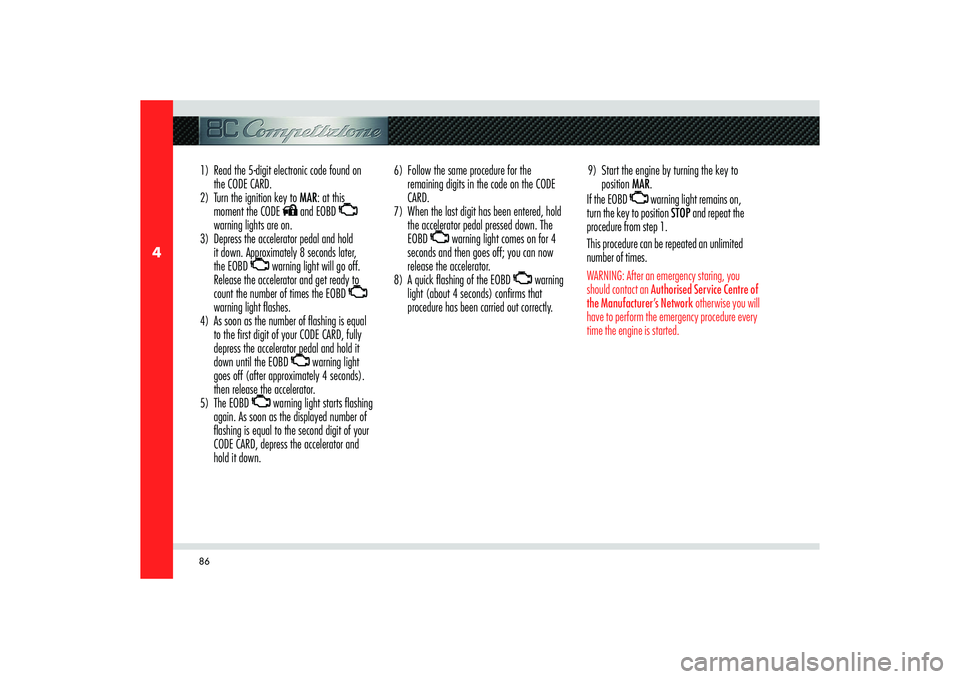
86
4
1) Read the 5-digit electronic code found on
the CODE CARD.
2) Turn the ignition key to MAR: at this
moment the CODE
and EOBD
warning lights are on.
3) Depress the accelerator pedal and hold
it down. Approximately 8 seconds later,
the EOBD warning light will go off.
Release the accelerator and get ready to
count the number of times the EOBD
warning light fl ashes.
4) As soon as the number of fl ashing is equal
to the fi rst digit of your CODE CARD, fully
depress the accelerator pedal and hold it
down until the EOBD warning light
goes off (after approximately 4 seconds).
then release the accelerator.
5) The EOBD warning light starts fl ashing
again. As soon as the displayed number of
fl ashing is equal to the second digit of your
CODE CARD, depress the accelerator and
hold it down.6) Follow the same procedure for the
remaining digits in the code on the CODE
CARD.
7) When the last digit has been entered, hold
the accelerator pedal pressed down. The
EOBD warning light comes on for 4
seconds and then goes off; you can now
release the accelerator.
8) A quick fl ashing of the EOBD warning
light (about 4 seconds) confi rms that
procedure has been carried out correctly.9) Start the engine by turning the key to
position MAR.
If the EOBD warning light remains on,
turn the key to position STOP and repeat the
procedure from step 1.
This procedure can be repeated an unlimited
number of times.
WARNING: After an emergency staring, you
should contact an Authorised Service Centre of
the Manufacturer’s Network otherwise you will
have to perform the emergency procedure every
time the engine is started.